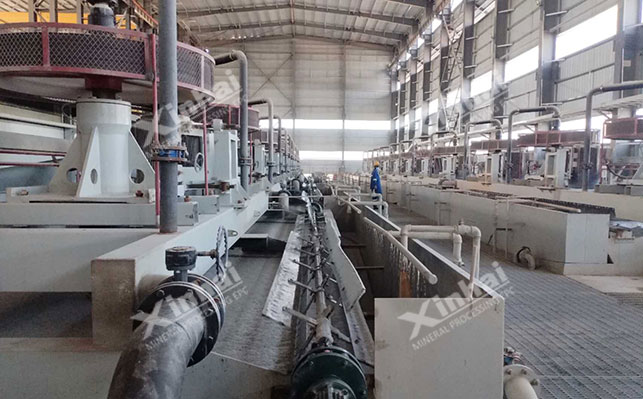
15311826613
Click to add WeChatGenerally, bauxite with a sulfur content greater than 0.7% is considered high-sulfur bauxite. At present, the treatment methods for high-sulfur bauxite can be divided into two categories. The first is to reduce the sulfur content in bauxite by pretreatment before the Bayer process produces alumina. The methods include flotation method, roasting method, microbial method, electrochemical method, etc. The second is desulfurization during the alumina production process, which removes the sulfur element in the sodium aluminate solution. It is mainly divided into precipitation method and oxidation method. Let's learn about these bauxite desulfurization methods together!
Flotation desulfurization is a relatively economical beneficiation method for blocking the source of high-sulfur bauxite and improving its quality. It uses the difference in the surface properties of sulfide ore and oxide ore in the slurry to separate them. It not only conforms to the flotation principle of "floating less and suppressing more", but also has the advantages of simple process and environmental protection. The main steps are to crush and screen the ore and stir it in a stirrer. After adding flotation reagents, the separation is completed by the difference in the surface properties of sulfur and aluminum minerals to obtain sulfur and aluminum concentrates, realizing the comprehensive utilization of resources.

Roasting desulfurization is a pyrometallurgical method with high efficiency and short process. It refers to a pretreatment method for desulfurization by high-temperature roasting to decompose the sulfur-containing minerals in high-sulfur bauxite to generate sulfur dioxide gas.
The roasting method not only removes the interference of organic matter while desulfurizing efficiently, but also improves the decomposition rate of alumina production species; and diaspore is dehydrated at high temperature, changing the microstructure of the crystal and improving the dissolution performance of the ore.
However, if the roasting time is too long, it will not only increase energy consumption and cost, but also gradually transform the transitional alumina formed by dehydration of diaspore into corundum with complete morphology and structure, which is not conducive to improving the dissolution rate of alumina.
At present, the temperature used in the roasting method is mostly above 600℃. Although high temperature can quickly remove sulfur, it is not conducive to saving roasting energy consumption and production costs.
The microwave roasting method is used to pre-treat high-sulfur bauxite for desulfurization, which has the characteristics of selective heating, that is, different mineral components in bauxite have different absorption capacities for microwaves, among which pyrite has significantly higher microwave absorption performance than diaspore and kaolinite. Under microwave roasting conditions, the Fe-S bond of pyrite breaks, and S2- continuously diffuses to the surface and contacts with oxygen, realizing rapid heating and desulfurization of pyrite.
Microwave roasting has the advantages of low roasting temperature, fast heating speed, uniform heating, short-time and high efficiency. At present, microwave roasting desulfurization is still in the laboratory research stage, and it is necessary to break through the limitations of high industrialization cost and difficult to ensure desulfurization effect under mass production conditions.
Some microorganisms have a certain oxidation ability, which can oxidize the low-valent sulfur ions in pyrite into SO42-, thereby realizing the biological oxidation desulfurization of high-sulfur bauxite. The production process cost and energy consumption of microbial desulfurization are low, which can effectively reduce environmental pollution, but the research carried out is relatively small and is still in the experimental stage. If we want to promote the marketization of microbial desulfurization technology, we need to further solve the problems of screening specific strains, high production environment requirements, difficult process control, long production cycle, and unstable desulfurization effect.
The precipitation method mainly involves adding barium salts (such as barium aluminate, barium hydroxide), zinc oxide, lime, etc. to the sodium aluminate solution to react with SO42- or S2- in the solution to form precipitation removal. The precipitation method has the advantage of simple process, but in theory it can only remove a single form of sulfur, and has limited effect on the removal of other valence states of sulfur such as thiosulfate in the circulating mother liquor. In addition, due to the high prices of desulfurizers such as barium salts and zinc salts, the desulfurization cost is relatively increased when the sulfur content of bauxite is high.
The oxidation method mainly adds oxidants (such as oxygen and sodium nitrate) during the dissolution process to oxidize low-valent sulfur ions such as S2-, S2O32-, and SO32- in the sodium aluminate solution into SO42-, and then precipitates in the evaporation process to achieve the purpose of desulfurization. The oxidation method can oxidize and remove most of the S2- in the sodium aluminate solution, but the oxidation effect on other forms of sulfur is not obvious. In the future, it is also necessary to further improve the problems of large consumption of solid oxidants, high investment costs, corrosion of steel equipment, and safety hazards.
The above is an introduction to the 6 types of bauxite desulfurization beneficiation methods. In actual beneficiation plants, bauxite desulfurization needs to be determined based on the sulfur content and other mineral compositions, because the properties of each bauxite ore are different. Therefore, it is necessary to conduct beneficiation test analysis first, and then design a suitable bauxite desulfurization process method according to the actual situation.